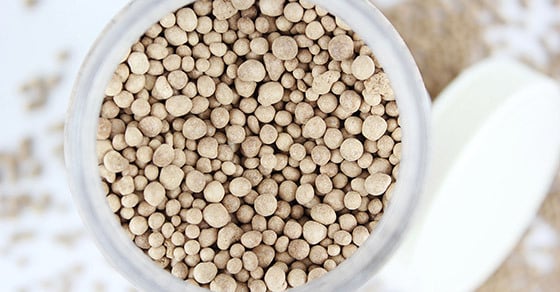While the disc pelletizer has long been the standard for producing granular limestone and gypsum, the industry has found that the addition of a preconditioning step prior to the disc pelletizer significantly improves both processing and product quality. In this application, the pin mixer has prevailed as the industry’s preferred choice for many reasons.
About Limestone & Gypsum
Limestone and gypsum are widely used throughout industrial applications as raw materials and end products. Most notably, they have long been, and continue to remain, popular soil amendments for use in agriculture and commercial turf applications.
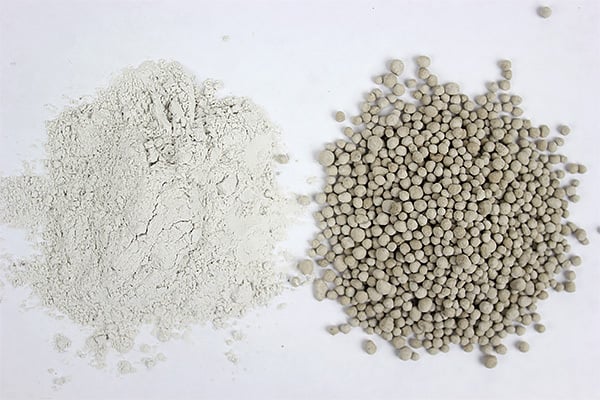
Raw and pelletized limestone
With similar characteristics and identical end use markets, limestone and gypsum are frequently processed using the same pelletizing production line. Historically, this process has consisted of a disc pelletizer and rotary dryer with a screening and recycle circuit, such as that shown in the diagram below.
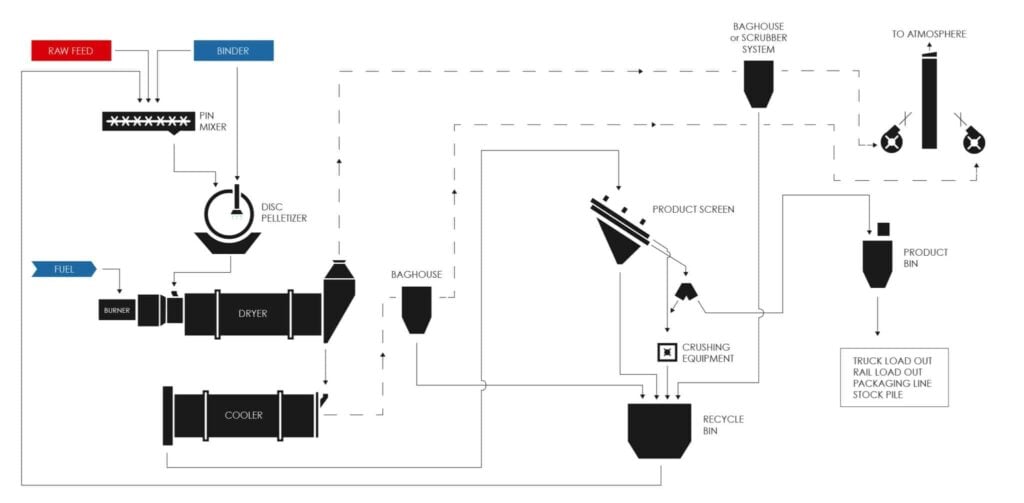
Typical limestone and gypsum disc pelletizing operational flow
This process produces adequate product, but as buyers become more discerning, maximizing product quality has become essential to maintaining a foothold in this competitive market, making the addition of a pin mixer an obvious choice.
Why Use a Mixer at All?
The addition of a mixer to a disc pelletizing operation yields a significantly better product, while simultaneously reducing processing costs and increasing production rates.
These benefits occur largely because a disc pelletizer does not thoroughly mix separate feedstocks, which can produce inconsistent results in the end product. The addition of the mixer increases binder distribution and product uniformity.
Furthermore, when using a disc pelletizer, densification of the product is produced through added binder, while the pin mixer produces densification through motion. As a result, reaching optimal densification with a disc pelletizer alone requires more binder and a longer retention time.
For a more detailed explanation on why the addition of a pin mixer is so beneficial to the disc pelletizing process, see The Benefits of Adding a Pin Mixer to a Limestone Disc Pelletizing System.
Advantages to the Pin Mixer for Limestone and Gypsum
The pin mixer has become the preferred industry choice for the many benefits it can offer.
Originally developed for processing carbon black, pin mixers are the device of choice when a uniform mixture must be produced from powdered fines and liquid feed. They have subsequently become the industry standard for de-dusting coal.
Pin mixers offer:
Better Binder Distribution
The rotational force that occurs in the mixing chamber, combined with strategically placed spray nozzles, maximizes the distribution of liquid binder throughout the solid feed for excellent distribution and uniformity.
Enhanced Size Control
Pin mixers allow for precision feed rates of liquid and solid feed for superior size control.
Increased Densification
The intense spinning action imparted by the pin mixer produces optimal material densification.
Improved Automation
Pin mixers are also an ideal device in an automated setting. Various data points can be gathered to monitor and adjust mixer efficiency and performance during processing via a control panel.
Continuous Operation
The pin mixer is a continuous device. This avoids the hassles of batch mixing while allowing for smooth, seamless production.
Customizability
Pin mixers are available in various configurations, with different sizes, horsepower, RPMs, and numerous optional features and design modifications available.
This bodes well for limestone and gypsum, which vary from one source to the next; even the same deposit of limestone can exhibit variability. Such variation demands a tailored mixer design based around the unique characteristics of the material to be processed.
How the Pin Mixer Works
The pin mixer’s single rotor shaft fitted with pins rotates at a high velocity, imparting an intense spinning action on the material inside the housing.
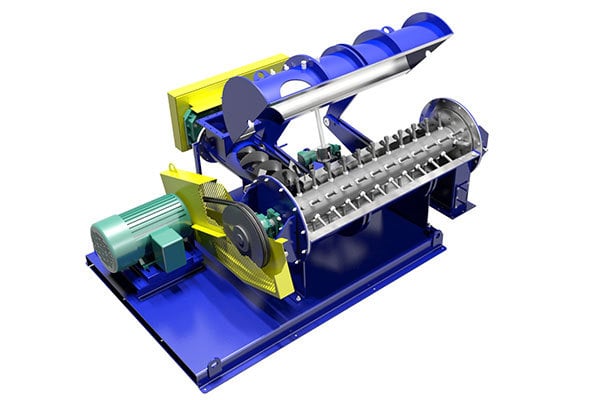
3D Model of a FEECO Pin Mixer
As liquid binder and solid feed are continuously fed into the mixer, the medium-shear spinning action produces a homogeneous mixture, yielding maximum product uniformity. As the mixture moves down the length of the mixer, “seed pellets” begin to form. Once seed pellets reach the intended size, they are discharged onto the disc pelletizer where they are further “grown” via coalescence.
Pin Mixer Design for Gypsum and Limestone
Since sources of limestone and gypsum can vary, along with production parameters, mixer design can vary across operations. However, in general, all utilize the following design specifications:
- Full-sweep pin design for optimal binder distribution, densification, seed pellet formation, and conditioning
- Polished stainless steel liner to discourage buildup
- Integrated screw feeder for solid feed introduction
- Multiple spray ports for optimal liquid binder dispersion
- Actuated hinged (screw jack) or clamshell cover for easy access
- Abrasion-resistant pin coating to prolong pin life
Capacity is dependent on production goals, but can range anywhere from 200 lb/hr to 70 TPH. Mixers can be provided in diameters from 10” – 50”.
*Please note that the specifications listed are specific to FEECO International.
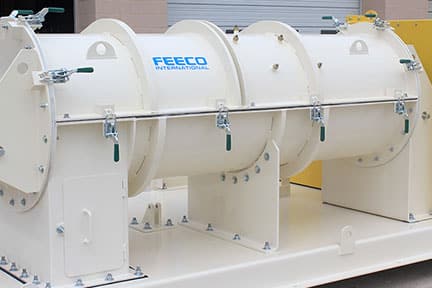
Clam shell Pin Mixer for Limestone and Gypsum Pelletizing
Testing Key to Success
A comprehensive testing program is essential to process success when working with limestone and gypsum, particularly given the variability exhibited by these materials. As such, FEECO recommends all materials go through batch and pilot testing in our Innovation Center. Testing can be conducted to:
- Confirm the viability of adding a pin mixer to an existing pelletizing operation
- Work out the process variables on a batch and continuous scale
- Test different binders and formulations
- Determine the necessary process parameters for producing a product with the target characteristics (bulk density, crush strength, flowability, moisture content, particle size distribution, etc.)
- Produce samples for field trials
Pelletizing has been compared to a combination of art and science, requiring expertise to efficiently produce a product of the desired quality. The pairing of disc pelletizer and pin mixer allow for numerous process variables to be adjusted on one or both machines, creating a complex matrix of processing parameters. Common variables that impact the pelletizing of limestone and gypsum include:
- Horsepower (pin mixer and/or disc pelletizer)
- Solids feed rate (pin mixer and/or disc pelletizer)
- Binder feed rate (pin mixer and/or disc pelletizer)
- Disc rotational speed
- Disc angle
- Disc solid and liquid feed positions
- Pin mixer RPMS
Conclusion
The pin mixer adds significant value to the limestone and gypsum pelletizing process, thanks to the many benefits it can offer to the process and end product. As a result, the pin mixer has become the preferred choice among limestone and gypsum producers. Testing remains a major contributor to the success of the process.
FEECO is the industry leader in limestone and gypsum production equipment and systems. Our pin mixers are custom designed around the material to be processed, based on data gathered during comprehensive testing programs. FEECO pin mixers are built to the highest quality standard for a reliable lifetime of operation. We can also test and provide complete pelletizing lines including the disc pelletizer, dryer, screening, and recycle circuits.
For more information on our pin mixers or limestone and gypsum pelletizing capabilities, contact us today.



